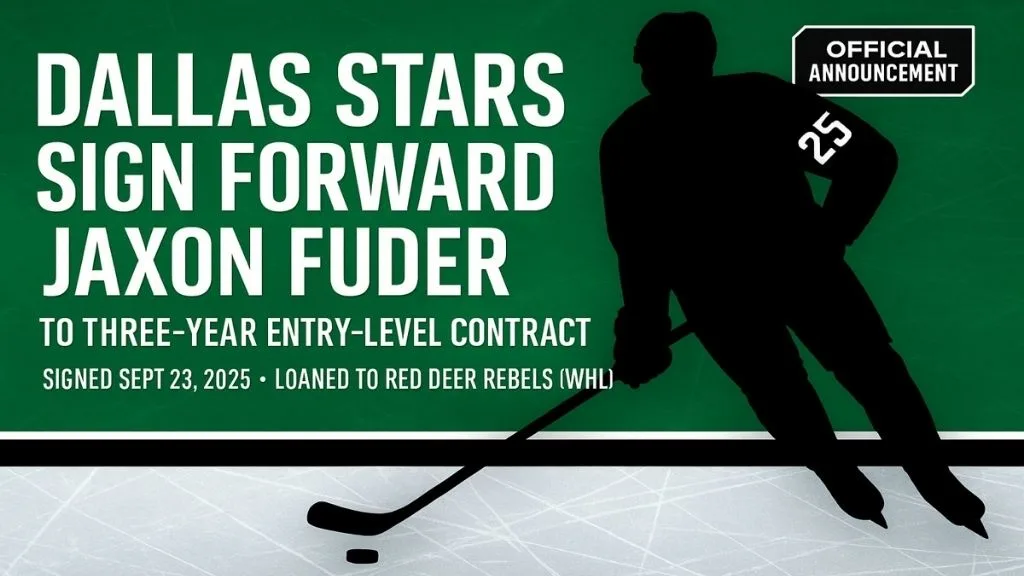The Dallas Stars have signed promising forward Jaxon Fuder to a three-year entry-level contract and, in the same breath, loaned him back to the WHL’s Red Deer Rebels for more seasoning. It’s a tidy, future-focused play: lock in the rights to a hungry 19-year-old who impressed at prospect games and camp, and let him cook with heavy minutes in junior before he takes aim at pro hockey next year.
The club highlighted his growth curve and last season’s recognition as Red Deer’s “Darcy Robinson Award” winner for the Rebels’ most underrated player—hockey’s version of an internal nod that teammates and staff see something real brewing.
| Key Details | Summary |
|---|---|
| Player | Jaxon Fuder, left-shot forward, age 19 |
| Contract | Three-year NHL entry-level deal (signed Sept 23, 2025) |
| Assignment | Loaned to Red Deer Rebels (WHL) for 2025-26 |
| 2024-25 WHL | 46 GP, 11 G, 15 A, 26 Pts; team’s “most underrated” award |
| Role Projection | Competitive two-way winger/center with forecheck drive and net-front habits |
Why Dallas Stars moved now
There are two headlines inside this headline. First, the Dallas Stars rewarded performance. Jaxon Fuder turned heads at the organization’s prospect event, showing the kind of straight-line speed, wall work, and retrieval game NHL coaches love. Second, the team secured an asset at a team-friendly cap slot under entry-level rules, preserving flexibility as the NHL roster chases another deep spring. The timing—late September—tracks with a broader Stars pattern: use camp and prospect showcases to spot risers, then get pen to paper before preseason lineups harden.
Contract snapshot and cap context
It’s an entry-level deal spanning three seasons, the standard bridge into the pro ranks for a 19-year-old. Public cap sites peg the ELC value at just under $2.75 million across the term with an annual cap hit in the customary ELC range; the important bit for fans is that the AAV sits in a predictable window while the upside—if Jaxon Fuder outperforms early—is all gravy for Dallas. That balance is exactly why teams like the Stars lean on young energy to round out veteran cores.
Who is Jaxon Fuder right now?
Strip away the fresh-ink hype and you’ll find a hardworking, left-shot forward who logged 46 games last season for Red Deer, finishing with 26 points. Those aren’t jaw-dropping totals, but the trend line matters more than the raw number. He built trust as a responsible, competitive piece, earned that “most underrated” tag from his own club, and then showed at prospect games that his speed and motor translate against better peers. That arc—from “useful junior” to “signed NHL prospect”—is classic development done right.
The tool kit: how Jaxon Fuder plays
Jaxon Fuder’s tape pops for three reasons. First, his pace: he gets up the ice quickly, hunts pucks on the forecheck, and arrives on time to make life miserable for defenders. Second, he works the middle with purpose—arriving at the interior, finding tips and rebounds, and drawing defenders into bad gaps. Third, there’s a responsible foundation to his shifts: he tracks, he reloads above the puck, and he reads pressure well enough to live on the right side of the puck. Project that forward and you can see a bottom-six NHL template with the upside to moonlight higher if the offense keeps climbing.
Why the “loan back” is a win
Dallas sending Jaxon Fuder back to Red Deer isn’t a demotion; it’s the plan. The biggest gift a team can give a 19-year-old is ice time in all situations, touches on the puck, and the freedom to make—and fix—mistakes with the game on the line. In the WHL he’ll be a go-to player, tasked with driving a line, reading top-pair matchups, and learning to create against the best checkers. That beats sheltered fourth-line minutes or sporadic AHL usage at this stage. It’s a development lane that has worked for Dallas before with other prospects who needed a final growth spurt of confidence and production.
How he fits the Stars’ depth chart
Zoom out and the Stars’ NHL roster leans on star power up top and role reliability down the lineup. Where Jaxon Fuder fits, long-term, is in that competitive middle—a winger or center who can push pace, forecheck, and win pucks back for skilled linemates. Think penalty-kill potential, late-game trust when protecting a one-goal lead, and the kind of relentless shift that tilts the ice even if you don’t touch the scoresheet. If the offense keeps blooming, you get a playoff-useful piece who can hang in heavy series and make life annoying for top pairings.
The production question—and the answer Dallas is betting on
Yes, 26 points in 46 WHL games won’t break the internet. But when organizations look at a prospect like Jaxon Fuder, they weigh age, role, and context. He was 18 for most of the season, played honest minutes in a structure-first program, and flashed more juice late in the year and at the prospect event. The Stars clearly think the shot volume and inside-lane habits point to a bigger box score in 2025-26. A leap from 0.56 points-per-game to the 0.8–0.9 range is realistic if he’s stapled to the top six and the first power-play net-front, spots he can earn with that motor.
What the award tells us about his ceiling
Red Deer’s Darcy Robinson Award, given to the team’s most underrated player, isn’t about flash; it’s about trust. Teammates and staff see the little things—smart chips, strong walls, hard backtracks—that don’t trend on social but win coaches over. For an NHL projection, that matters. Prospects who stack trust early often break into lineups faster because coaches can use them anywhere, at any time. That’s the runway Jaxon Fuder is on.
Body type and measurables
The profile reads like a modern middle-six skater: around six feet, mid-170s in listed weight, left shot, with enough quickness to beat first contact and enough balance to live in the blue paint. Those measurables match the role his game suggests—agile, sturdy enough for battles, quick enough to pressure exits, and light on his edges to dart into shooting lanes.
The contract’s hidden value for a contender
Entry-level deals are the alchemy behind salary-cap contenders. Dallas gets three years of cost-controlled utility from a player whose game fits a bottom-six right away and could grow into more. If he earns NHL minutes while on the ELC, the Stars essentially “bank” cap value, allowing them to pay established stars at the top of the roster. That surplus value is exactly how deep teams keep adding at the deadline without blowing up their future.
What a successful WHL season looks like
The stat line that would move the needle for Jaxon Fuder this year is simple: 30-plus goals or 70-plus points would confirm real finishing touch, but even a balanced jump to 25-30 goals with strong even-strength shot share would check the right boxes. More important will be his special-teams growth—net-front on PP1, first over the boards on the PK, and the trust to take late-game defensive-zone draws if he’s used at center. With that, the path to the AHL—and a cup of coffee in the NHL—opens up quickly.
The Dallas Stars’ recent track with this pathway
Dallas Stars hasn’t been shy about plucking late risers or undrafted types who show they can drive play at development events, then marinating them in junior or the AHL. It’s a complement to the club’s headline drafting and smart pro scouting. In short: the process is the point. Identify traits that translate—pace, retrieval, inside play, and coachability—then bet on the frame and the habits. Jaxon Fuder fits that mold cleanly.
What coaches will harp on next
If you’re building the checklist for Jaxon Fuder between now and spring, it likely reads like this: add a little more lower-body strength for battles, sharpen the first three strides to create separation after steals, and improve the quick give-and-go touch so he can play at NHL tempo in the slot. The good news is that these are trainable skills, and they compound quickly when you’re playing 18–20 minutes a night with the puck on your stick.
How the Stars could use him in preseason a year from now
Project forward to September 2026 and imagine him arriving at camp after a big WHL season. The deployment writes itself: third-line looks with a veteran pivot, penalty-kill reps in preseason, and a game or two riding shotgun with a skilled line to test finishing against NHL competition. If he clears those bars, you could see a nine-game NHL look before any AHL assignment, keeping the door open for him to force the decision with performance.
The fan-friendly bottom line
For supporters, this is the kind of signing you root for. Jaxon Fuder isn’t being asked to save the franchise; he’s being asked to be himself—fast, honest, inside-driven—and to raise his own personal ceiling one month at a time. It’s smart business by Dallas, it rewards a player who earned his shot, and it feeds a development pipeline that already fuels a contender. That’s good hockey housekeeping in Texas.
A snapshot of Jaxon Fuder’s 2024-25 statistical base
Last season’s 26 points in 46 games gives Jaxon Fuder a sturdy base to build on. He wasn’t a power-play merchant; a lot of his touches came at even strength, and that’s a positive sign for translatability when he climbs the ladder to the AHL. If he adds a half-step of burst and gets a few more pucks through traffic, a 30-goal WHL year is on the table. Dallas clearly sees that trajectory; that’s why the contract arrived before the calendar flipped to October.
Why “most underrated” matters in a room
Awards voted on inside a room—by staff who grade every shift—carry weight. Being stamped as the most underrated player says teammates want him on the ice when the game tightens. NHL benches love that. Jaxon Fuder’s calling card is that he wins small moments reliably. Stack enough of those moments and you stay in a lineup for a long time.
What to watch with Red Deer this season
Keep an eye on three markers. One: net-front touches on the power play; more tips and rebounds usually mean the hands are catching up to the feet. Two: controlled entries at even strength; if he’s carrying cleanly across the blue more often, the confidence is rising. Three: penalty-kill reads; smart sticks and quick clears are the currency that buys NHL coaches’ trust. If Jaxon Fuder boxes those out by January, expect him to be among the WHL’s better two-way forwards by spring.
The human angle that makes this story easy to like
Beyond the numbers, there’s the vibe. Jaxon Fuder was not a marquee name on draft day. He climbed. He adjusted. He used prospect games to make a case, then answered when the door cracked open. That journey resonates in any sport and in any dressing room. Dallas didn’t just sign a stat line; they signed the habits behind it—and those tend to travel well.
Final word on the signing
Viewed through a contender’s lens, this is a low-risk, high-upside bet on a player whose game blends with the way Dallas wants to play: quick to pucks, heavy on retrievals, inside the dots, and annoying to defend. If the offense pops this year in Red Deer, you’ll hear the name a lot more next fall. For now, the Stars have a fresh ELC in the drawer and a motivated Jaxon Fuder on a mission to make it count.
FAQs
Who is Jaxon Fuder and what position does he play?
Jaxon Fuder is a 19-year-old left-shot forward who has played both wing and center. He’s known for pace, forechecking pressure, and willing net-front routes that create second-chance offense.
What exactly did the Dallas Stars announce?
Dallas Stars announced a three-year entry-level contract for Jaxon Fuder and immediately loaned him to the WHL’s Red Deer Rebels for the 2025-26 season to continue his development with top-line minutes.
How did Jaxon Fuder perform last season?
He recorded 26 points in 46 games for Red Deer and earned the Rebels’ “most underrated player” honor, signaling strong two-way value and room for offensive growth.
What are the contract basics and why do they matter?
It’s a three-year entry-level deal with a typical ELC cap hit, giving Dallas cost-controlled depth while Jaxon Fuder develops. If he earns NHL shifts during the deal, the Stars gain valuable cap efficiency.
When might he push for NHL games?
If Jaxon Fuder translates a bigger WHL role into higher production this season and carries that into a strong 2026 training camp, a nine-game NHL look or an AHL jump could be on the table, depending on organizational needs.







